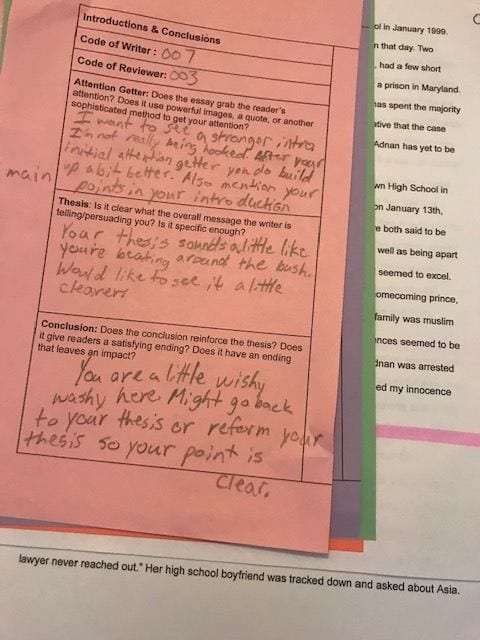I’ve tried dozens of ways for students to peer review each other. Analog styles, such as using post-it notes or forms. Digital, online ways using special programs or comments on Google docs.
A year or two ago, I read one of Starr Sackstein’s books, where she described how she jigsawed her peer reviews, where groups focused on one specific area of a paper, such as organization, word choice, or introduction.
After a few rounds, jigsaw peer reviews have soundly become my favorite form of peer review to do with my students. Here’s why I think it works:
- It’s more kinesthetic. We use hard copies, and it allows readers to feel more connected. That kinesthetic feel can’t be replaced.
- It’s more social. Starting in groups and comparing ideas, peer feedback becomes a social activity.
- It’s scaffolded. We start by working in groups and then release to independent work, though conferring with partners is always allowed.
- It’s less overwhelming. By only focusing on one section or aspect of a paper, students aren’t overwhelmed by longer papers or papers from struggling writers.
Prep:
-
- I print off all the drafts from a Google folder using Mergy to merge them together into one PDF.
- I give each student a secret code (like 001, 002, etc.) and write it at the top of the paper. They also use their code later when reviewing. It keeps feedback anonymous. I write the code at the top of each paper in lieu of the writer’s name.

- I print the forms for each of my groups (see below) using a different color for each group. For argument papers, as we just finished, my groups are Intros & Conclusions, Section 1, Section 2, and Section 3. (To make the process smoother for students, I also highlight the thesis and draw lines between sections so they’re easy to locate) (For narrative writing, groups might focus on character development, setting, dialogue, and plot structure.)
Introducing Peer Review:
Generally, most students have done forms of peer review when they reach my classroom, so my emphasis is on expectations and the why. First, I reinforce WHY we do this: one, it provides feedback (and this is the obvious reason), but two, I emphasize that they become better writers through this process. They will see how other writers “move” in their papers and start thinking about their own “moves.”
Then, I show them examples of comments that meet and don’t meet expectations (last page of the Google Doc embedded above.)
Round 1 of Peer Review:
I split students into small groups no larger than four students and place each group in charge of one section. I give each group 2-4 papers. Each group member must read their assigned section of EACH paper. Then, the group’s recorder writes on the colored form the feedback that the group has for each paper. (Groups might only have one recorder, or they might take turns).
This takes time if it’s done well. I don’t rush students through this. I want them to discuss these papers, the feedback they want to give, and how to tactfully give that feedback. On average, round 1 takes 20-30 minutes.
After Round 1:
Once the group has carefully discussed and given feedback to all the original papers given to the group, I tell them they can start working independently, completing the colored forms on their own. Of course, they still have their group to confer with if they need ideas or help with their paper.
On the second day (this usually takes us two periods–we don’t have block scheduling), groups read for a different section than they did on the first day. Another alternative is I’ll give each group a few feedback forms of each color. Readers can simply see which sections still need read on that paper based on what colored forms are still missing (readers staple their forms to the papers when finished).
Let me also mention the benefit of using different colors for each section. In one glance, we all know if a paper has feedback for all its sections or which section it’s missing.
What Do I Do During the Process?
I answer questions from readers. I give them feedback ideas if they’re struggling with a paper. I move papers from one group to another. Sometimes I hand specific papers to specific readers because the reader might have a helpful background knowledge about the topic, or maybe the writer needs a “special touch” from a tactful reader. If the writer is in the same room at the same time their paper is being read, I make sure their paper bypasses their group and lands elsewhere.
The Day After Peer Review!
Two things. Obviously, students then receive their own papers back and have feedback from four different readers. They use that feedback to revise their papers (in addition to the comments I’ve also given them–generally, I try to focus on giving students two comments that will most help their paper).
Second, students then vote on their favorite feedback giver. Using a Google form, each student gets to vote on the student code who gave them the most helpful and specific feedback. Those winners are recognized in class and earn extra XP, gold, or something else in our game.
Conclusion
I’ll admit it–this is more work than digital feedback. It takes more planning and more prep time. The result, however, is the best feedback I’ve seen in all my years of teaching. This system provides more accountability to me and to each other than anything else I’ve used, and writers take their given feedback much more seriously. The 60-90 minutes of prep time is that much time I receive back when I’m reading and evaluating final drafts.





Leave a Reply